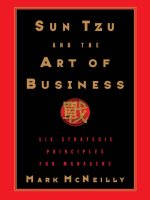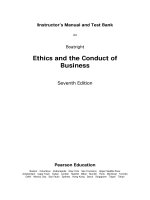Ethics and the conduct of business 8th by john boatright and smith 2017 chapter 3
Bạn đang xem bản rút gọn của tài liệu. Xem và tải ngay bản đầy đủ của tài liệu tại đây (133.19 KB, 15 trang )
Ethics and the Conduct of Business
Eighth edition
Chapter 3
Ethical Theories
Copyright © 2017, 2012, 2009 Pearson Education, Inc. All Rights Reserved
Modules
•
Introduction: Ethical Theories
•
3.1: Utilitarianism
•
3.2: Kantian Ethics
•
3.3: Virtue Ethics
•
3.4: Rights
•
3.5: Justice
•
Conclusion: Ethical Theories
Copyright © 2017, 2012, 2009 Pearson Education, Inc. All Rights Reserved
Learning Objectives (1 of 2)
•
3.1: Describe the four theses of classical utilitarianism, the utilitarian approach to decision making, and
the main criticisms of the cost-benefit analysis method
•
3.2: Summarize the two intuitive principles of Kantian ethics and their implications for moral reasoning
•
3.3: Define virtue and explain how virtues and principles of virtue ethics are relevant to business
•
3.4: Identify the meaning and importance of rights and the types of rights that apply in different
situations
Copyright © 2017, 2012, 2009 Pearson Education, Inc. All Rights Reserved
Learning Objectives (2 of 2)
•
3.5: Explain the role of justice in business ethics, the three kinds of justice outlined by Aristotle, and the
contemporary principles of justice offered by Rawls and Nozick
Copyright © 2017, 2012, 2009 Pearson Education, Inc. All Rights Reserved
Introduction: Ethical Theories
•
Types of ethical theories
•
Teleological theories
•
Deontological theories
•
Virtue ethics
Copyright © 2017, 2012, 2009 Pearson Education, Inc. All Rights Reserved
Figure 3.1
Copyright © 2017, 2012, 2009 Pearson Education, Inc. All Rights Reserved
3.1: Utilitarianism
Objective: Describe the four theses of classical utilitarianism, the utilitarian approach to decision making, and the main criticisms of the cost-benefit analysis
method
3.1.1: Principle of Utility
Four these of utilitarian principle
Act- and rule-utilitarianism
Calculating utility
3.1.2: Cost-Benefit Analysis
Quantitative method for decision making
Advantage of cost-benefit analysis
Evaluation of cost-benefit analysis
Assigning monetary values
Copyright © 2017, 2012, 2009 Pearson Education, Inc. All Rights Reserved
Table 3.1: Pros and Cons of Cost-Benefit Analysis
Points
Consequences measured by monetary value in a market
Shadow pricing of nonmarket goods
Placing a value on human life and experiences
Copyright © 2017, 2012, 2009 Pearson Education, Inc. All Rights Reserved
Pros
Cons
The market price or value of goods and services can be used to
Not all costs and benefits have a discernible market value or can
compare outcomes.
be objectively valued.
Market value can be estimated by analyzing the relative worth of
Not all people are able to act or choose in accordance with their
choices suggested by actual behavior.
preferences, or make rational decisions.
Can apply cost-benefit analysis to issues such as human health
Seems cold-hearted and reductive; life, love, happiness, etc.
and safety
cannot be bought and are cheapened by assigned values
3.2: Kantian Ethics
Objective: Summarize the two intuitive principles of Kantian ethics and their implications for moral reasoning
3.2.1: Universalizability
Categorical imperative
Implications for moral reasoning
3.2.2: Respect for Persons
Features
Respect people as human beings
Copyright © 2017, 2012, 2009 Pearson Education, Inc. All Rights Reserved
3.3: Virtue Ethics
Objective: Define virtue and explain how virtues and principles of virtue ethics are relevant to business
3.3.1: What Is Virtue?
Aristotle’s idea about virtue
Characteristics of virtuous people
3.3.2: Defending the Virtues
Traits required for a good life
3.3.3: Virtue in Business
Applying virtue ethics to business
Copyright © 2017, 2012, 2009 Pearson Education, Inc. All Rights Reserved
Table 3.2: Virtues and Vices in Business
Job
Virtue
Vice
Bank loan officer
Prudence, Caution
Charity
School guidance counselor
Empathy, Enthusiasm
Indifference
Personnel manager
Resourcefulness, Impartiality
Prejudice
Corporate executive
Confidence, Focus
Arrogance
Copyright © 2017, 2012, 2009 Pearson Education, Inc. All Rights Reserved
3.4: Rights
Objective: Identify the meaning and importance of rights and the types of rights that apply in different situations
3.4.1: Meaning of Rights
Confusing claim of rights
Understanding rights as entitlements
3.4.2: Kinds of Rights
Different kinds of rights
Natural rights theory by John Locke
Copyright © 2017, 2012, 2009 Pearson Education, Inc. All Rights Reserved
3.5: Justice (1 of 2)
Objective: Explain the role of justice in business ethics, the three kinds of justice outlined by Aristotle, and the contemporary principles of justice offered by
Rawls and Nozick
3.5.1: Nature and Value of Justice
Aristotle’s categorization of justice
3.5.2: Aristotle on Distributive Justice
Aristotle’s principle of distributive justice
Justifying features
3.5.3: Rawls's Egalitarian Theory
Rawl’s principle on justice
Copyright © 2017, 2012, 2009 Pearson Education, Inc. All Rights Reserved
3.5: Justice (2 of 2)
Objective: Explain the role of justice in business ethics, the three kinds of justice outlined by Aristotle, and the contemporary principles of justice offered by
Rawls and Nozick
3.5.4: Nozick's Entitlement Theory
Difference between Rawls’s theory and Nozick’s theory
Main principles of Nozick’s theory
Copyright © 2017, 2012, 2009 Pearson Education, Inc. All Rights Reserved
Conclusion: Ethical Theories
•
Main concepts and theories of ethics
•
Useful in evaluating business activities
•
Continue to be a source for improvement
Copyright © 2017, 2012, 2009 Pearson Education, Inc. All Rights Reserved









